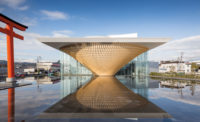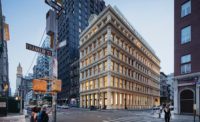Video by Redsquare Productions
Stand on the corner of South Spring Street and East Hyman Avenue in downtown Aspen, Colorado, and you see two entrances to Shigeru Ban’s box-like Aspen Art Museum, his first completed project in the United States since winning the 2014 Pritzker Architecture Prize. To your right is the main entrance, a recessed section in the building’s striking woven-lattice exterior. To your left is a smaller cutout leading to a 10-foot-wide grand staircase, sandwiched between the woven screen and a glass curtain wall. Walk up the stairs, and you’ll find yourself in the rooftop sculpture garden, with its spectacular views of Aspen’s ski slopes and 12,095-foot Independence Pass.
If Ban had his way, this is how all visitors would enter the museum. “I wanted to make something very site-specific,” he says. “You go to the rooftop first, enjoy the beautiful view, then come down one floor at a time to see the art. It’s the same kind of experience as skiing. You take the ski lift up, enjoy the view, and then ski down the mountain.”
Museum director and chief curator Heidi Zuckerman Jacobson sees things differently. “When I take people through the museum,” she says, “I do the opposite, because I feel like it becomes increasingly spectacular as you go up. I like the big ‘mega moment’ at the end.”
No matter how the museum experience connects to its context, it’s fitting that Ban’s first American museum is located in Aspen, which has a rich history of forward-
thinking architecture—even if several of its most significant works are now lost. Structures by Eero Saarinen, Herbert Bayer, Harry Weese, and Buckminster Fuller, to name a few, have come and gone. These days, the city is better known for its luxury vacation homes, and, if you know where to look, you can spot houses by John Lautner, Peter Gluck, and Antoine Predock, as well as one by Renzo Piano.
The 33,000-square-foot, $45 million project adds to that architectural legacy, and replaces the Aspen Art Museum’s longtime home, a former power plant near the banks of the Roaring Fork River. Zuckerman Jacobson, who took the museum’s helm in 2005, led efforts to move to a larger facility, and in 2008, the museum announced the selection of Ban, from a list of 36 firms under consideration by the museum, to design a new building. His original scheme, for a sloping site in a five-acre swath of downtown—part of a multimillion-dollar redevelopment plan to create a new civic center—was scrapped in 2009 when voters rejected the sale of a former youth center that would have been razed to make room for the museum. After the vote, museum officials decided to look elsewhere.
For the museum’s new, far more constrained site, in the heart of downtown Aspen, Ban conceived a hybrid concrete-steel-and-wood structure enclosed on two sides by glass walls set behind the woven screen. The museum is a simple box inserted into the streetscape, but one that is open to its surroundings through a controlled series of sight lines. “I didn’t just want to make a black-box building shielded from its context,” Ban says.
From the exterior, the museum’s main feature is the basket-weave cladding that covers its two street-facing facades. The slats, “woven” together on-site, are made from a paper-and-resin composite sandwiched between two thin layers of brown okoume wood protected with a UV coating. The density of the weave changes from top to bottom and as it moves away from the corner of the building. Practically, the screen provides shade from the intense Colorado sunlight. Aesthetically, it helps give the museum a craftsy, homemade quality, despite its bulky presence.
Because the museum has no permanent collection, the program called for open, flexible spaces that could accommodate a variety of contemporary artwork. All six galleries are column-free, with 14-foot-high ceilings. Ban calls them “very practical white boxes.” Although several galleries are partially illuminated by skylights, they are essentially blank slates. A show that pairs work by David Hammons and Yves Klein feels uncluttered, with paintings, drawings, and prints generously spaced on stark walls. The museum’s largest gallery, which occupies most of the second level, contains an exhibition of full-scale disaster-relief structures designed by Ban. It runs through October 5.
At almost every turn, visitors to the museum can look out to Aspen’s stunning mountain setting. A small lounge off the second-floor gallery, for example, has views through large openings in the lattice to nearby Red Mountain. The grand staircase actually has two parallel parts: that 10-foot-wide section between the glass skin and the exterior screen, and a 5-foot-wide section running inside the building, but either route offers glimpses of treetops and surrounding mountains. Even the large public elevator, in the building’s most prominent corner, has glass walls—Ban calls it a “moving glass room.”
The rooftop sculpture garden occupies roughly half of the museum’s third level, which also houses a small café behind sliding glass doors that open to create a spectacular indoor-outdoor space. A delicate triangular wood-truss roof, supported by discreet white steel columns, hovers over the café and part of the sculpture garden. The curvy trusses, stained with a light natural finish, were assembled without using any visible metal joints—only well-concealed screws. Like the exterior screen, the timber space frame—indeed, the entire museum—displays Ban’s gift for blending craftsmanship and architecture.
Going from the original hilly setting with an obvious connection to the topography to a tighter urban site could have led to an inward-looking building. But Ban is smart enough to know that Aspen is all about the out of doors. Here, even an art museum, with its climate-controlled galleries, needs to connect to nature. And that’s what the museum does, brilliantly. In Aspen, you can’t compete with the mountains.
RECORD .
PeopleOwner: Architect : Personnel in architect's firm who should receive special credit: Dean Maltz, Partner, (registered architect) Project Team: Architect of record: Personnel in Executive Architect’s Firm: Engineer(s): IN ASSOCIATION WITH HERMANN BLUMER (CRÉATION HOLZ GMBH) POSTFACH / TOBELACKERSTRASSE 6 CH-9101 HERISAU SWITZERLAND MEP/IT/AV Engineer: Cvil Engineer: Consultant(s): Landscape: Lighting: Acousticas: Other: Climate Engineering: Specialty Timber Fabricator: Specialty Exterior Cladding Fabricator (Woven Screen): Specialty Glass Curtain Wall, Floor & Skylight Fabricator: Food Service: Elevator: General contractor: Photographer(s): CAD system, project management, or other software used: Size: 33,000 square feet Completion date: August 2014 |
ProductsStructural system Roof: Manufacturer of any structural components unique to this project: SPECIALTY TIMBER FABRICATOR: Exterior cladding: Metal/glass curtain wall: Curtain wall, Windows, Skylights, Structural Glass Floors: Rainscreen: Wood: Moisture barrier: Other cladding unique to this project: Construction Specialties Exterior Louver Roofing Windows Glazing Glass: Skylights: Insulated-panel or plastic glazing: Other: Doors Sliding doors: Hardware Closers: Exit devices: Pulls: Security devices: Other special hardware: Interior finishes Suspension grid: Demountable partitions: Cabinetwork and custom woodwork: Birch Plywood, Paper Tubes (by OX Paper Tube), Corian, Plastic Laminate Solid surfacing: Special surfacing: Resilient flooring: Carpet: Special interior finishes unique to this project: Lighting Interior ambient lighting: Downlights: Exterior: Dimming System or other lighting controls: Conveyance Plumbing Add any additional building components or special equipment that made a significant contribution to this project: Exterior Paving: Noted above. |




















Post a comment to this article
Report Abusive Comment